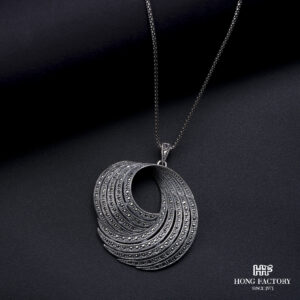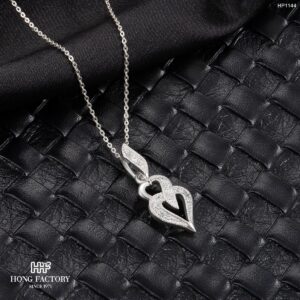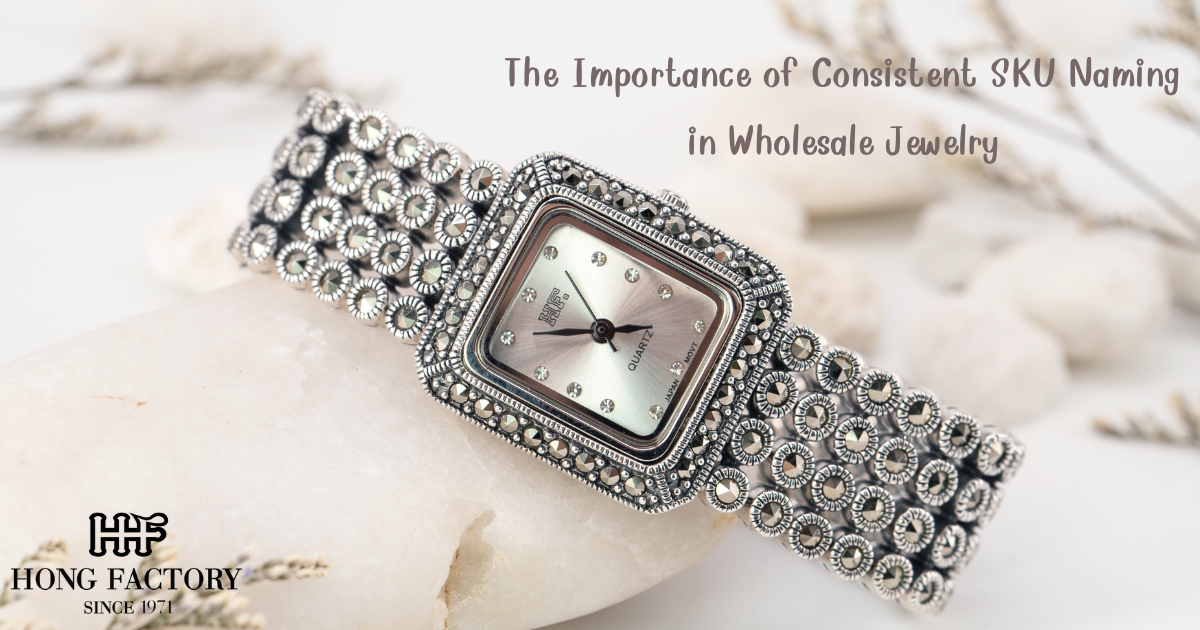In the wholesale jewelry business, efficient product management is critical not just for inventory control, but also for seamless communication, fast order processing, and smooth B2B relationships. One of the most overlooked elements that can either streamline or complicate these operations is SKU naming.
Stock Keeping Units (SKUs) are more than just codes. They’re an essential part of your product architecture, especially when dealing with thousands of designs, variations, and reorders. In this article, we explore why consistent SKU naming is vital in the jewelry industry, how it affects multiple aspects of the business, and how to create a system that supports scale and clarity.
The Importance of Consistent SKU Naming in Wholesale Jewelry

Why SKU Naming Matters in Jewelry Wholesale
Jewelry wholesalers typically manage a large catalog across styles, materials, gemstones, sizes, and finishes. Without a structured system for identifying and referencing each item, your operations can quickly become chaotic.
Key reasons consistency is essential:
- Enables fast and accurate ordering for B2B buyers
- Prevents product misidentification in fulfillment
- Reduces human error across supply chain and sales teams
- Supports data analysis and forecasting
- Builds trust and professionalism in client communications
Common Problems from Inconsistent SKU Systems
1. Confused Customers and Sales Teams
When SKUs lack structure, it’s hard for buyers to locate or reorder specific pieces. Sales teams may waste time manually confirming details.
2. Inaccurate Fulfillment and Shipping Errors
Mismatch between SKU names, product labels, and images can result in incorrect shipments, returns, or complaints.
3. Inventory Disorganization
Without a uniform SKU structure, managing stock levels across designs and locations becomes difficult and error-prone.
4. Reporting Challenges
Inconsistent SKU formats make it harder to generate accurate reports on sales trends, top performers, or inventory aging.
What a Good Jewelry SKU System Should Achieve
An ideal SKU naming convention allows you to:
- Instantly identify key product attributes (e.g., metal type, gemstone, category)
- Group products logically across categories and collections
- Scale efficiently with new collections and seasonal drops
- Maintain internal and external clarity (including for third-party retailers)

Key Elements to Include in Jewelry SKUs
A strong jewelry SKU code should include concise information. For example:
Example SKU: R-S925-MTQ-S6
Where:
- R = Ring
- S925 = Sterling silver
- MTQ = Marcasite + Turquoise
- S6 = Size 6
This format tells your team and your customer what they’re getting at a glance—and helps prevent miscommunication.
How to Build a Consistent SKU Naming Structure
Step 1: Define Your Product Categories
Assign clear identifiers for rings, earrings, pendants, necklaces, bracelets, brooches, watches, etc.
- R = Ring
- E = Earrings
- N = Necklace
- B = Bracelet
- P = Pendant
- W = Watch
Step 2: Include Material or Metal Type
Define shorthand codes:
- S925 = Sterling Silver
- G18 = 18K Gold Plated
- RG = Rose Gold
- STS = Stainless Steel
Step 3: Add Gemstone or Design Type
Use abbreviations or codes for common combinations:
- MAR = Marcasite
- AM = Amethyst
- PRL = Pearl
- CZ = Cubic Zirconia
Step 4: Specify Size or Variation
- S6 = Size 6
- A = Adjustable
- LG, MD, SM = Size indicators for bangles or necklaces
Step 5: Optional – Add Season, Year, or Collection Code
Helps with reporting and trend tracking:
- SS24 = Spring/Summer 2024
- VNTG = Vintage Collection
- MOD = Modern Collection
Tips for Implementing SKU Consistency Across Your Organization
1. Document Your Naming Convention
Create a reference guide for your team, vendors, and B2B buyers. This ensures everyone speaks the same SKU language.
2. Train Your Staff
Sales, fulfillment, and support teams must understand how SKUs are built and how to decode them quickly.
3. Audit Your Existing Database
Identify inconsistencies and standardize all legacy SKUs. You may need to migrate to a new format gradually.
4. Use Digital Tools for Automation
Integrate your SKU system into inventory management software to automatically generate new codes and prevent duplication.
5. Communicate Clearly with Buyers
Ensure your brochures, online catalogs, and order forms list clear SKUs for every item especially when offering customizable or made-to-order options.

Real-World Impact of SKU Standardization
A wholesale silver jewelry supplier with over 10,000 designs transitioned from alphanumeric product codes to a modular SKU structure. The result:
- 30% faster order processing
- 60% drop in picking and packing errors
- Improved buyer satisfaction and reorder frequency
SKU naming may not be glamorous but it’s a silent force behind efficient operations and strong customer relationships in the jewelry wholesale world. Inconsistent codes slow your team, confuse your buyers, and create costly mistakes.
By adopting a structured, scalable, and brand-aligned SKU system, you’ll not only streamline internal workflows but also elevate your professionalism and reliability in the eyes of your customers. In the end, consistency isn’t just about control. It’s about clarity, growth, and trust the real gems of long-term success.


